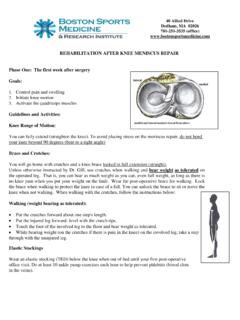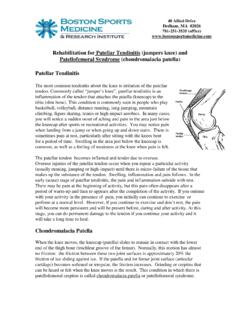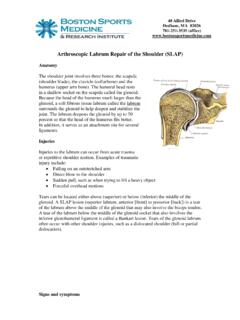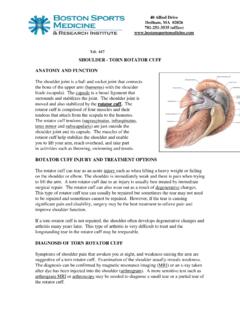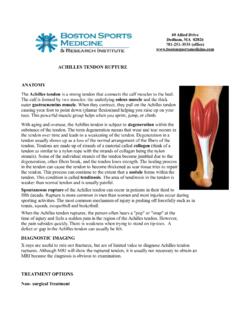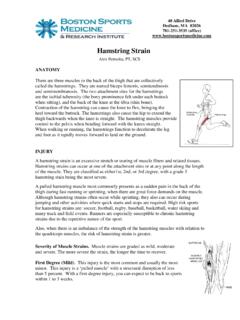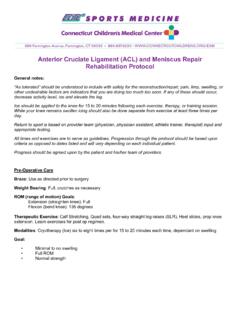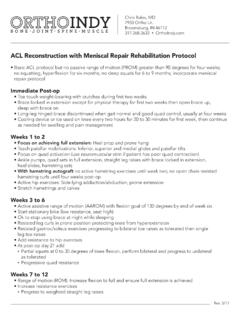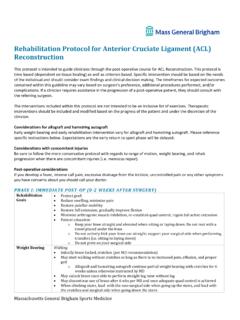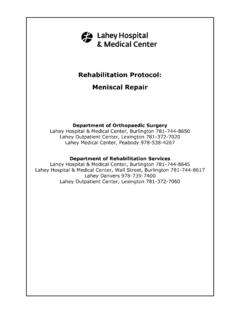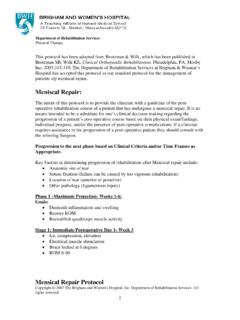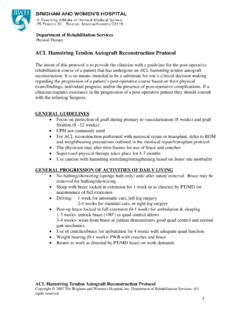Transcription of REHABILITATION AFTER KNEE MENISCUS REPAIR Goals
1 40 Allied Drive Dedham, MA 02026 781-251-3535 (office) REHABILITATION AFTER knee MENISCUS REPAIR Phase One: The first week AFTER surgery Goals : 1. Control pain and swelling 2. Initiate knee motion 3. Activate the quadriceps muscles Guidelines and Activities: knee Range of Motion: You can fully extend (straighten the knee ). To avoid placing stress on the MENISCUS REPAIR , do not bend your knee beyond 90 degrees (bent to a right angle) Brace and Crutches: You will go home with crutches and a knee brace locked in full extension (straight). Unless otherwise instructed by Dr. Gill, use crutches when walking and bear weight as tolerated on the operated leg. That is, you can bear as much weight as you can, even full weight, as long as there is no knee pain when you put your weight on the limb. Wear the post-operative brace for walking. Lock the brace when walking to protect the knee in case of a fall.
2 You can unlock the brace to sit or move the knee when not walking. When walking with the crutches, follow the instructions below: Walking (weight bearing as tolerated): Put the crutches forward about one step's length. Put the injured leg forward; level with the crutch tips. Touch the foot of the involved leg to the floor and bear weight as tolerated. While bearing weight (on the crutches if there is pain in the knee ) on the involved leg, take a step through with the uninjured leg. Elastic Stockings Wear an elastic stocking (TED) below the knee when out of bed until your first post-operative office visit. Do at least 10 ankle pump exercises each hour to help prevent phlebitis (blood clots in the veins). 40 Allied Drive Dedham, MA 02026 781-251-3535 (office) Exercise Program: QUADRICEPS SETTING - to maintain muscle tone in the thigh muscles and straighten the knee . Lie or sit with the knee extended fully straight as in figure.
3 Tighten and hold the front thigh muscle making the knee flat and straight. If done correctly, the kneecap will slide slightly upward toward the thigh muscle. The tightening action of the quadriceps should make your knee straighten and be pushed flat against the bed or floor. Hold 5 seconds for each contraction. Do 20 repetitions three times a day. HEEL PROP- to straighten (extend) the knee . Lie on your back with a rolled up towel under your heel or sit in a chair with the heel on a stool as shown in the figure. Let the knee relax into extension (straight). If the knee will not straighten fully, you can place a weight (2 to 5 pounds) on the thigh, just above the kneecap. Try to hold this position for 5 minutes, three times a day. While maintaining this extended position, practice quadriceps setting. SITTING HEEL SLIDES - to regain the bend (flexion of the knee ). While sitting in a chair or over the edge of your bed, support the operated leg with the uninvolved leg.
4 Lower the operated leg, with the unoperated leg controlling it. Allow the knee to bend but DO NOT exceed 90 degrees of bend at the knee . Hold five seconds and slowly relieve the stretch by lifting the foot upward, helping with the uninvolved leg, to the straight position (passive assist). Repeat exercise 20 times, three times a day. ANKLE PUMPS - to stimulate circulation in the leg. You should do at least 10 ankle pump exercises each hour. OFFICE VISIT Please return to Dr. Gill s office approximately 10-14 days AFTER your surgery. 40 Allied Drive Dedham, MA 02026 781-251-3535 (office) REHABILITATION AFTER knee MENISCUS REPAIR Phase Two: 2 to 6 weeks AFTER surgery Goals : 1. Protect the knee from overstress and allow healing 2. Regain knee motion, limiting knee flexion to 90 degrees 3. Begin muscle strengthening knee Range of Motion: You can fully extend (straighten the knee ).
5 To avoid placing stress on the MENISCUS REPAIR , do not bend your knee beyond 90 degrees (bent to a right angle). Brace and Crutches: Unless otherwise instructed by Dr. Gill, use crutches when walking and bear weight as tolerated on the operated leg. Wear the post-operative brace for walking. Lock the brace with the knee fully straight when walking to protect the knee in case of a fall. You can unlock the brace to sit or move the knee when not walking. When walking with the crutches, follow the instructions below: Walking (Weight bearing as tolerated), brace locked in full extension: Put the crutches forward about one step's length. Put the injured leg forward; level with the crutch tips. Touch the foot of the involved leg to the floor and bear as much weight as you can without pain If you cannot bear full weight without pain, place some of your weight on the crutches so that there is no pain with weight bearing If you are able to bear full weight without pain, you can taper to one crutch, held on the opposite side of your affected knee .
6 If you continue to have no pain with weight bearing, you can discontinue the crutch and walk with the brace only locked in full extension. Exercise Program The following exercise program should be followed as directed by the doctor or the physical therapist. Do the exercises daily unless otherwise noted. 40 Allied Drive Dedham, MA 02026 781-251-3535 (office) QUADRICEPS SETTING - to maintain muscle tone in the thigh muscles and straighten the knee . Lie on your back with the knee extended fully straight. Tighten and hold the front thigh muscle making the knee flat and straight. If done correctly, the kneecap will slide slightly upward toward the thigh muscle. The tightening action of the quadriceps should make your knee straighten and be pushed flat against the bed or floor. Hold 5 seconds for each contraction. Do 20 repetitions three times a day until you can fully straighten your knee equal to the unoperated side.
7 HEEL PROP - to straighten (extend) the knee . Lie on your back with a rolled up towel under your heel or sit in a chair with the heel on a stool as shown in. Let the knee relax into extension (straight). If the knee will not straighten fully, you can place a weight (2 to 5 pounds) on the thigh, just above the kneecap. Try to hold this position for 5 minutes, three times a day. While maintaining this extended position, practice quadriceps setting. SITTING HEEL SLIDES - to regain the bend (flexion of the knee ). See figure in phase 1. While sitting in a chair or over the edge of your bed, support the operated leg with the uninvolved leg. Lower the operated leg, with the unoperated leg controlling, allowing the knee to bend but DO NOT exceed 90 degrees of bend at the knee . Hold five seconds and slowly relieve the stretch by lifting the foot upward, helping with the uninvolved leg, to the straight position (passive assist).
8 Repeat exercise 20 times, three times a day. STRAIGHT LEG LIFT The quality of the muscle contraction in this exercise is what counts the most, not just the ability to lift the leg! 1. Tighten the quadriceps (quadriceps setting) as much as you can, push the back of the knee against the floor. 2. Tighten this muscle harder! 3. Lift your heel 4 to 6 inches off the floor 4. Tighten the quadriceps harder again. 5. Lower your leg and heel back to the floor. Keep the quadriceps as tight as possible. 6. Tighten this muscle harder again. 7. Relax and repeat . 40 Allied Drive Dedham, MA 02026 781-251-3535 (office) If the knee bends when you attempt to lift the limb off of the bed, do not do this exercise. Keep trying to do the quadriceps setting exercise until you can lift the limb without letting the knee bend. SHORT ARC LIFT With the knee bent over a rolled up towel or blanket of a height of 4-5 inches (the knee should be bent only 20-25 degrees), lift the foot so that the knee fully straightens.
9 Hold the knee locked in extension for 5 seconds, then slowly lower. Repeat 20 times. ANKLE PUMPS - to stimulate circulation in the leg. See figure in phase 1. You should do at least 10 ankle pump exercises each hour. HIP ABDUCTION Lie on your unoperated side. Keep the knees fully extended. Raise the operated limb upward to a 45 degree angle as illustrated. Hold one second, and then lower slowly. Repeat 20 times. If the straight leg lift, short arc lift and side leg lift can be performed easily AFTER the first week, then an ankle weight may be used to increase the resistance of the exercise and to build strength. Start with one pound and add one pound per week until you reach five pounds. Do the exercises daily for the first week, then decrease to every other day when using ankle weights. STANDING TOE RAISE Stand facing a wall, hands on the wall for support and balance. Keep the knees extended fully. Tighten the quadriceps to hold the knee fully straight.
10 Raise up on tip-toes while maintaining the knees in full extension. Hold for one second, then lower slowly to the starting position. Repeat 20 times. WALL SLIDES Stand upright with your back and buttocks touching a wall. Place the feet about 12 inches apart and about 6 inches from the wall. You will be bearing 50% of your weight (or less on the affected side) on each leg. Slowly lower your hips by bending the knees and slide down the wall until the knees are flexed about 45 degrees (illustration). Pause five seconds and then slowly slide back up to the upright starting doing a wall slide, you should position your thighs so that your kneecaps are in line with the tips of your shoes, or your second toe, and try to keep equal weight on both feet. Do 20 reps. 40 Allied Drive Dedham, MA 02026 781-251-3535 (office) REHABILITATION AFTER knee MENISCUS REPAIR Phase Three: Six to twelve weeks AFTER surgery Goals : 1.
